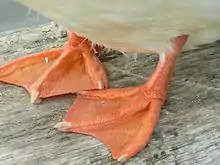蹼
| ||||||||
Translingual
Glyph origin
| Characters in the same phonetic series (菐) (Zhengzhang, 2003) | |
|---|---|
| Old Chinese | |
| 樸 | *baː, *pʰroːɡ, *poːɡ, *boːɡ |
| 璞 | *pʰroːɡ |
| 墣 | *pʰroːɡ, *pʰoːɡ |
| 撲 | *broːɡ, *pʰoːɡ |
| 轐 | *poːɡ, *buːɡ |
| 獛 | *poːɡ |
| 蹼 | *poːɡ |
| 襆 | *poːɡ, *boɡ |
| 濮 | *poːɡ |
| 纀 | *poːɡ |
| 醭 | *pʰoːɡ |
| 僕 | *boːɡ, *buːɡ |
| 菐 | *boːɡ, *puɡ |
| 穙 | *boːɡ |
| 鏷 | *buːɡ |
| 幞 | *boɡ |
Phono-semantic compound (形聲, OC *poːɡ) : semantic 足 (“foot”) + phonetic 菐 (OC *boːɡ, *puɡ).
Han character
蹼 (radical 157, 足+12, 19 strokes, cangjie input 口一廿金人 (RMTCO), four-corner 62134, composition ⿰𧾷菐)
References
- KangXi: page 1234, character 9
- Dai Kanwa Jiten: character 37889
- Dae Jaweon: page 1706, character 16
- Hanyu Da Zidian: volume 6, page 3739, character 7
- Unihan data for U+8E7C
Japanese
Kanji
蹼
- This term needs a translation to English. Please help out and add a translation, then remove the text
{{rfdef}}.
Korean
Hanja
蹼 • (bok) (hangeul 복, revised bok, McCune–Reischauer pok, Yale pok)
- This term needs a translation to English. Please help out and add a translation, then remove the text
{{rfdef}}.
This article is issued from Wiktionary. The text is licensed under Creative Commons - Attribution - Sharealike. Additional terms may apply for the media files.
